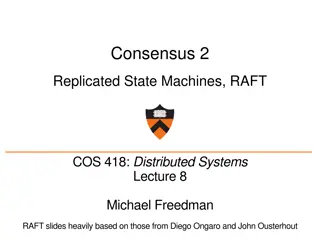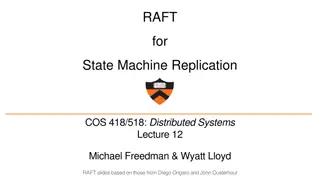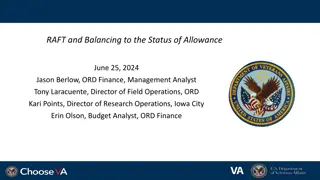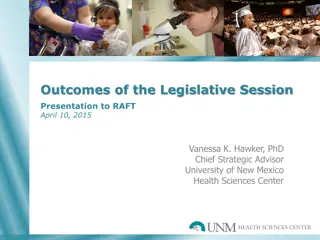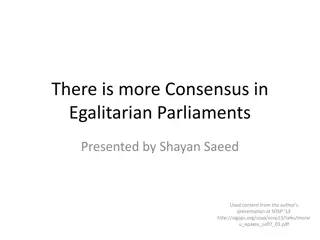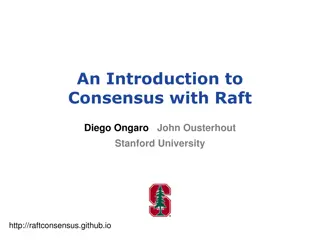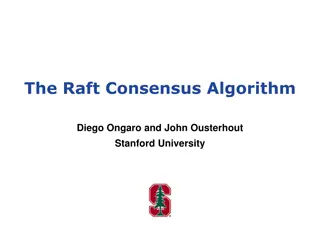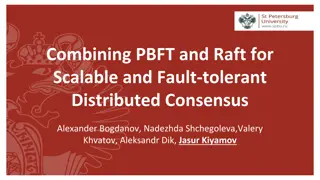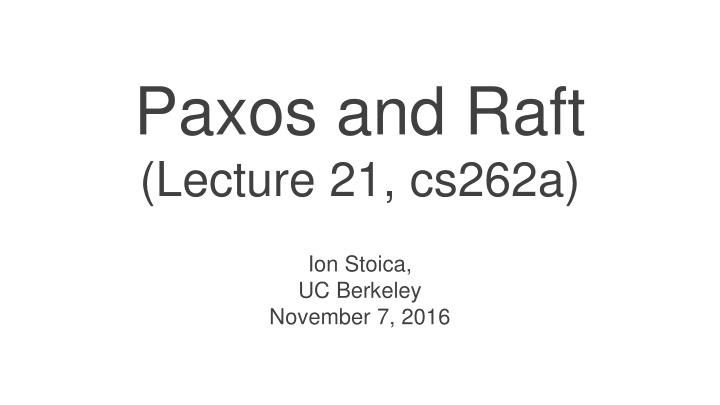
Decentralized Consensus Algorithms: Exploring Paxos and Raft
Learn about Paxos and Raft, two essential decentralized consensus algorithms used for achieving agreement among distributed processes. Understand the concepts of distributed consensus problems, consensus impossibility, and dealing with various types of failures in a non-Byzantine model.
Download Presentation

Please find below an Image/Link to download the presentation.
The content on the website is provided AS IS for your information and personal use only. It may not be sold, licensed, or shared on other websites without obtaining consent from the author. If you encounter any issues during the download, it is possible that the publisher has removed the file from their server.
You are allowed to download the files provided on this website for personal or commercial use, subject to the condition that they are used lawfully. All files are the property of their respective owners.
The content on the website is provided AS IS for your information and personal use only. It may not be sold, licensed, or shared on other websites without obtaining consent from the author.
E N D
Presentation Transcript
Paxos and Raft (Lecture 21, cs262a) Ion Stoica, UC Berkeley November 7, 2016
Bezos mandate for service-oriented-architecture (~2002) All teams will henceforth expose their data and functionality through service interfaces. Teams must communicate with each other through these interfaces. There will be no other form of interprocess communication allowed: no direct linking, no direct reads of another team's data store, no shared-memory model, no back-doors whatsoever. The only communication allowed is via service interface calls over the network. It doesn't matter what technology they use. HTTP, Corba, Pubsub, custom protocols -- doesn't matter. All service interfaces, without exception, must be designed from the ground up to be externalizable. That is to say, the team must plan and design to be able to expose the interface to developers in the outside world. No exceptions. Anyone who doesn't do this will be fired. Thank you; have a nice day! 1. 2. 3. 4. 5. 6. 7.
Todays Papers Paxos Made Simple, Leslie Lamport (research.microsoft.com/en-us/um/people/lamport/pubs/paxos-simple.pdf) In Search of an Understandable Consensus Algorithm, Diego Ongaro and John Ousterhout, USENIX ATC 14 (https://ramcloud.stanford.edu/raft.pdf)
Paxos Based on many slides from Indranil Gupta s presentation: (https://courses.engr.illinois.edu/cs525/sp2013/L9_paxos.sp13.ppt), and Gene Pang s presentation (www.cs.berkeley.edu/~istoica/classes/cs294/11/notes/07-gene-paxos.pptx)
Distributed consensus problem Group of processes must agree on a single value Value must be proposed After value is agreed upon, it can be learned
Consensus Impossibility Result Byzantine Generals Problem Why cannot reach consensus?
Two types of failures Non Non- -Byzantine Byzantine Failed nodes stop communicating with other nodes "Clean" failure Fail Fail- -stop stop behavior Byzantine Byzantine Failed nodes will keep sending messages Incorrect and potentially misleading Failed node becomes a traitor traitor Assumption: asynchronous, non-byzantine model
Paxos L. Lamport, The Part-Time Parliament, September 1989 Aegean island of Paxos A part-time parliament Goal: determine the sequence of decrees passed (consensus!)
Political Science Analogy Paxos has rounds: each round has a unique ballot ID Rounds are asynchronous Time synchronization not required If you are in round j and hear a message from round j+1, abort everything and go to round j+1 Each round Phase 1: A leader is elected (election) Phase 2: Leader proposes a value (bill), processes acks Phase 3: Leaders multicast final value (law)
Does Paxos Solve Consensus? Provides safety and liveness Safety: Only a value which has been proposed can be chosen Only a single value can be chosen A process never learns a value unless it was actually chosen Eventual liveness: If things go well at some point in the future (e.g., losses, failures), consensus is eventually reached. However, this is not guaranteed.
So Simple, So Obvious In fact, it is among the simplest and most obvious of distributed algorithms. - Leslie Lamport
3 Types of Agents Proposers Acceptors Learners
Simple Implementation Typically, every process is acceptor, proposer, and learner A leader is elected to be the distinguished proposer and learner Distinguishes proposes to guarantee progress Avoid dueling proposers Distinguishes learner to reduce too many broadcast messages
Political Analogy Paxos has rounds: each round has a unique ballot ID Rounds are asynchronous Time synchronization not required If you are in round j and hear a message from round j+1, abort everything and move to round j+1 Each round consists of three phases Phase 1: A leader is elected (Election) Phase 2: Leader proposes a value, processes acks (Bill) Phase 3: Leader multicasts final value (Law)
Phase 1 Election Potential leader chooses a unique ballot ID, higher than anything it has seen so far Sends ballot ID to all processes Processes respond to highest ballot id If potential leader sees a higher ballot id, it can t be a leader Paxos tolerant to multiple leaders, but we ll mainly discuss only one leader case Processes also log received ballot ID on disk OK! Please elect me!
Phase 1 Election If a process has in a previous round decided on a value v , it includes value v in its response If majority (i.e., quorum) respond OK then you are the leader If no one has majority, start new round A round cannot have two leaders (why?) OK! Please elect me!
Phase 2 Proposal (Bill) Leader sends proposal value v to all If some process already decided value v in a previous round send v = v Recipient log on disk, and responds OK Value v ok? OK! OK! Please elect me!
Phase 3 Decision (Law) If leader hears OKs from majority, it lets everyone know of the decision Recipients receive decisions, log it on disk Value v ok? v! OK! OK! Please elect me!
When is Consensus Achieved? When a majority of processes hear proposed value and accept it: Are about to respond (or have responded) with OK! At this point decision has been made even though Processes or even leader may not know! What if leader fails after that? Keep having having rounds until some round complete Value v ok? v! OK! OK! Please elect me!
Safety Assume a round with a majority hearing proposed value v and accepting it (mid of Phase 2). Then subsequently at each round either: The round chooses v as decision The round fails Proof : Potential leader waits for majority of OKs in Phase 1 At least one will contain v (because two majority sets intersect) It will choose to send out v in Phase 2 Success requires a majority, and two majority sets intersects Value v ok? v! OK! OK! Please elect me!
Basic Paxos Protocol Phase 1a: Prepare Select proposal number* N and send a prepare(N) request to a quorum of acceptors. Phase 1b: Promise If N > number of any previous promises or acceptances, * promise to never accept any future proposal less than N, - send a promise(N, U) response (where U is the highest-numbered proposal accepted so far (if any)) Proposer Phase 2a: Accept! If proposer received promise responses from a quorum, - send an accept(N, W) request to those acceptors (where W is the value of the highest-numbered proposal among the promise responses, or any value if no promise contained a proposal) Acceptor Phase 2b: Accepted If N >= number of any previous promise, * accept the proposal - send an accepted notification to the learner * = record to stable storage
Trivial Example: P1 wants to propose A P1 A1 prepare(1) A2 L1
Trivial Example: P1 wants to propose A promise(1)promise(1) P1 A1 prepare(1) A2 prepare(1) L1
Trivial Example: P1 wants to propose A promise(1)promise(1) P1 A1 prepare(1) accept(1, A) A2 prepare(1) accept(1, A) L1
Trivial Example: P1 wants to propose A promise(1)promise(1) P1 A1 prepare(1) accept(1, A) A2 prepare(1) accept(1, A) L1 accepted(A) accepted(A)
Example P1 A1 prepare(1) A2 L1
Prepare Example P1 A1 Prepare(10) Highest Accept: (5, A) Highest Prepare: 15 A2 prepare(10) Highest Accept: (5, A) Highest Prepare: 8
Prepare Example Promise(10, (5, A)) P1 A1 Prepare(10) Highest Accept: (5, A) Highest Prepare: 15 A2 prepare(10) Highest Accept: (5, A) Highest Prepare: 8 Highest Accept: (5, A) Highest Prepare: 10
Simple Accept Example P1 Assume it got promise for 10 from a quorum A1 Highest Accept: (5, A) Highest Prepare: 15 accept(10, A) A2 Highest Accept: (5, A) Highest Prepare: 10 accept(10, A) L1
Simple Accept Example P1 Assume it got promise for 10 from a quorum A1 Highest Accept: (5, A) Highest Prepare: 15 accept(10, A) A2 Highest Accept: (5, A) Highest Prepare: 10 accept(10, A) L1 accepted(A)
Example: Livelock P1 P2 A1 A1: Highest accept; (5, A) Highest prepare: 8
Example: Livelock promise(10, (5, A)) P1 P2 A1 prepare(10) A1: Highest accept; (5, A) Highest prepare: 10
Example: Livelock promise(10, (5, A)) P1 Promise(11,(5, A)) P2 A1 prepare(10) prepare(11) A1: Highest accept; (5, A) Highest prepare: 11
Example: Livelock promise(10, (5, A)) P1 Promise(11,(5, A)) P2 A1 prepare(10) prepare(11) accept(10, A) A1: Highest accept; (5, A) Highest prepare: 11
Example: Livelock promise(10, (5, A)) promise(12, (5, A)) P1 Promise(11,(5, A)) P2 A1 prepare(10) accept(10, A) prepare(12) prepare(11) A1: Highest accept; (5, A) Highest prepare: 12
Example: Livelock promise(10, (5, A)) promise(12, (5, A)) P1 Promise(11,(5, A)) Promise(13,(5, A)) P2 A1 prepare(13) prepare(10) accept(10, A) prepare(12) prepare(11) A1: Highest accept; (5, A) Highest prepare: 13
Example: P1 want to propose value A P1 P2 A1 prep(5) A2 prep(5) A3 prep(5) L
Example: P1 want to propose value A prom(5) prom(5) P1 P2 A1 prep(5) A2 prep(5) A3 prep(5) L
Example: P1 want to propose value A prom(5) prom(5) P1 P2 A1 prep(5) accept(5, A) A2 prep(5) accept(5, A) A3 prep(5) accept(5, A) L
Example: P1 want to propose value A prom(5) prom(5) accepted(A) P1 P2 A1 prep(5) accept(5, A) A2 prep(5) accept(5, A) A3 prep(5) accept(5, A) L accepted(A)
prom(5, (3, C)) prom(5, (4, D)) prom(5, (2, B)) Example accepted(D) P1 P2 A1 prep(5) accept(5,D) A2 prep(5) accept(5, D) A3 prep(5) accept(5, D) L Accepted(D)
Example: P1 wants A, and P2 wants B prom(5) prom(5) P1 prom(8) prom(8) P2 A1 prep(5) prep(8) A2 prep(5) prep(8) A3 prep(8) prep(5) L accepted(A)
Example: P1 wants A, and P2 wants B prom(5) prom(5) P1 prom(8) prom(8) P2 A1 prep(5) prep(8) accept(5, A) A2 prep(5) accept(5, A) prep(8) A3 prep(8) prep(5) accept(5, A) L
Example: P1 wants A, and P2 wants B prom(5) prom(5) P1 prom(8) prom(8) P2 A1 accept(B) prep(5) prep(8) accept(5, A) A2 accept(B) prep(5) accept(5, A) prep(8) A3 prep(8) prep(5) accept(5, A) accept(B) L
Example: P1 wants A, and P2 wants B prom(5) prom(5) P1 Accepted(B) prom(8) prom(8) P2 A1 accept(B) prep(5) prep(8) accept(5, A) A2 accept(B) prep(5) accept(5, A) prep(8) A3 prep(8) prep(5) accept(5, A) accept(B) L Accepted(B)
Others In practice send NACKs if not accepting a promise Promise IDs should increase slowly Otherwise too much too converge Solution: different ID spaces for proposers
Raft Many slides from Diego Ongaro & John Ousterhout presentation: (http://www2.cs.uh.edu/~paris/6360/PowerPoint/Raft.ppt)



